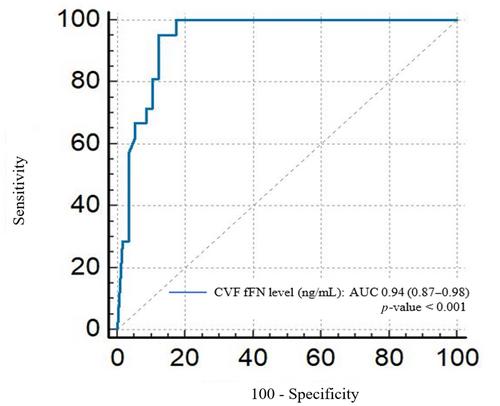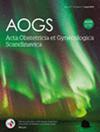Quantitative cervicovaginal fluid fetal fibronectin: A liquid biopsy for intra-amniotic inflammation
Abstract
Introduction
Intra-amniotic inflammation is causally linked to spontaneous preterm labor. The gold standard for the diagnosis of intra-amniotic inflammation is the determination of an amniotic fluid profile obtained from transabdominal amniocentesis, which is invasive. Cervicovaginal fluid fetal fibronectin (fFN) is a widely-used predictive biomarker for spontaneous preterm labor. The aims of this study are to determine (1) whether a quantitative cervicovaginal fluid fFN test can be used to identify the presence of intra-amniotic inflammation; and (2) an appropriate cut-off value of a cervicovaginal fluid fFN concentration for the identification of intra-amniotic inflammation.
Material and Methods
This prospective cohort study included 78 patients with preterm labor and intact membranes who had a sample collected for quantitative cervicovaginal fluid fFN measurement and underwent transabdominal amniocentesis. Intra-amniotic inflammation was defined as an amniotic fluid interleukin-6 concentration ≥2.6 ng/mL. Clinicians were masked from the results of cervicovaginal fluid fFN and amniotic fluid interleukin-6 concentrations. Logistic regression analysis was used to determine which factors were significant predictors of intra-amniotic inflammation. The diagnostic indices of the cervicovaginal fluid fFN test for the identification of intra-amniotic inflammation were calculated.
Results
(1) Frequency of intra-amniotic inflammation was 26.9% (21/78); (2) the higher the cervicovaginal fluid fFN concentration, the greater the risk of intra-amniotic inflammation (p < 0.001); (3) cervicovaginal fluid fFN concentration ≥125 ng/mL had an area under the curve of 0.91 (95% confidence interval: 0.83–0.96) for the identification of intra-amniotic inflammation with 100% sensitivity, 100% negative predictive value, 82.46% specificity and a positive likelihood ratio of 5.7; and (4) cervicovaginal fluid fFN cut-off of 125 ng/mL had a significant higher predictive performance than the traditional cut-off (50 ng/mL) for the identification of intra-amniotic inflammation.
Conclusions
Quantitative cervicovaginal fluid fFN with a cut-off of 125 ng/mL had a high sensitivity and a negative predictive value as well as a positive likelihood ratio for the identification of intra-amniotic inflammation. Its high sensitivity and negative predictive value can be used to decrease an index of suspicion of intra-amniotic inflammation. This test may be useful as an initial assessment test to select appropriate patients for amniocentesis to determine intra-amniotic inflammation.



 求助内容:
求助内容: 应助结果提醒方式:
应助结果提醒方式:


